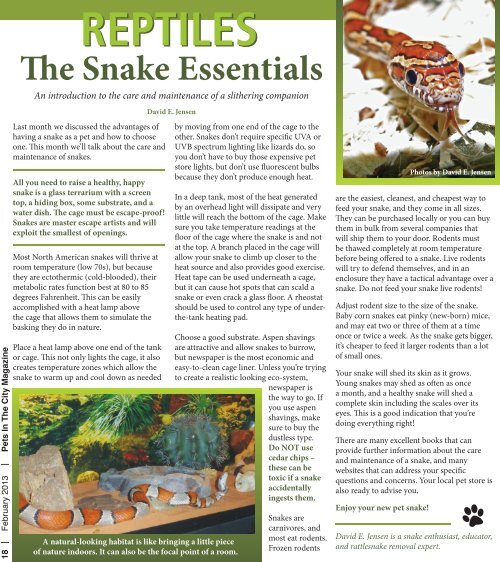Always Free February 2013 - Pets in the City Magazine
Always Free February 2013 - Pets in the City Magazine
Always Free February 2013 - Pets in the City Magazine
Create successful ePaper yourself
Turn your PDF publications into a flip-book with our unique Google optimized e-Paper software.
18 <strong>February</strong> <strong>2013</strong> <strong>Pets</strong> In The <strong>City</strong> Magaz<strong>in</strong>e<br />
REPTILES<br />
The Snake Essentials<br />
An <strong>in</strong>troduction to <strong>the</strong> care and ma<strong>in</strong>tenance of a sli<strong>the</strong>r<strong>in</strong>g companion<br />
Last month we discussed <strong>the</strong> advantages of<br />
hav<strong>in</strong>g a snake as a pet and how to choose<br />
one. This month we’ll talk about <strong>the</strong> care and<br />
ma<strong>in</strong>tenance of snakes.<br />
All you need to raise a healthy, happy<br />
snake is a glass terrarium with a screen<br />
top, a hid<strong>in</strong>g box, some substrate, and a<br />
water dish. The cage must be escape-proof!<br />
Snakes are master escape artists and will<br />
exploit <strong>the</strong> smallest of open<strong>in</strong>gs.<br />
Most North American snakes will thrive at<br />
room temperature (low 70s), but because<br />
<strong>the</strong>y are ecto<strong>the</strong>rmic (cold-blooded), <strong>the</strong>ir<br />
metabolic rates function best at 80 to 85<br />
degrees Fahrenheit. This can be easily<br />
accomplished with a heat lamp above<br />
<strong>the</strong> cage that allows <strong>the</strong>m to simulate <strong>the</strong><br />
bask<strong>in</strong>g <strong>the</strong>y do <strong>in</strong> nature.<br />
Place a heat lamp above one end of <strong>the</strong> tank<br />
or cage. This not only lights <strong>the</strong> cage, it also<br />
creates temperature zones which allow <strong>the</strong><br />
snake to warm up and cool down as needed<br />
David E. Jensen<br />
by mov<strong>in</strong>g from one end of <strong>the</strong> cage to <strong>the</strong><br />
o<strong>the</strong>r. Snakes don’t require specific UVA or<br />
UVB spectrum light<strong>in</strong>g like lizards do, so<br />
you don’t have to buy those expensive pet<br />
store lights, but don’t use fluorescent bulbs<br />
because <strong>the</strong>y don’t produce enough heat.<br />
In a deep tank, most of <strong>the</strong> heat generated<br />
by an overhead light will dissipate and very<br />
little will reach <strong>the</strong> bottom of <strong>the</strong> cage. Make<br />
sure you take temperature read<strong>in</strong>gs at <strong>the</strong><br />
floor of <strong>the</strong> cage where <strong>the</strong> snake is and not<br />
at <strong>the</strong> top. A branch placed <strong>in</strong> <strong>the</strong> cage will<br />
allow your snake to climb up closer to <strong>the</strong><br />
heat source and also provides good exercise.<br />
Heat tape can be used underneath a cage,<br />
but it can cause hot spots that can scald a<br />
snake or even crack a glass floor. A rheostat<br />
should be used to control any type of under<strong>the</strong>-tank<br />
heat<strong>in</strong>g pad.<br />
Choose a good substrate. Aspen shav<strong>in</strong>gs<br />
are attractive and allow snakes to burrow,<br />
but newspaper is <strong>the</strong> most economic and<br />
easy-to-clean cage l<strong>in</strong>er. Unless you’re try<strong>in</strong>g<br />
to create a realistic look<strong>in</strong>g eco-system,<br />
newspaper is<br />
<strong>the</strong> way to go. If<br />
you use aspen<br />
shav<strong>in</strong>gs, make<br />
sure to buy <strong>the</strong><br />
dustless type.<br />
Do NOT use<br />
cedar chips –<br />
<strong>the</strong>se can be<br />
toxic if a snake<br />
accidentally<br />
<strong>in</strong>gests <strong>the</strong>m.<br />
Snakes are<br />
carnivores, and<br />
most eat rodents.<br />
Frozen rodents<br />
are <strong>the</strong> easiest, cleanest, and cheapest way to<br />
feed your snake, and <strong>the</strong>y come <strong>in</strong> all sizes.<br />
They can be purchased locally or you can buy<br />
<strong>the</strong>m <strong>in</strong> bulk from several companies that<br />
will ship <strong>the</strong>m to your door. Rodents must<br />
be thawed completely at room temperature<br />
before be<strong>in</strong>g offered to a snake. Live rodents<br />
will try to defend <strong>the</strong>mselves, and <strong>in</strong> an<br />
enclosure <strong>the</strong>y have a tactical advantage over a<br />
snake. Do not feed your snake live rodents!<br />
Adjust rodent size to <strong>the</strong> size of <strong>the</strong> snake.<br />
Baby corn snakes eat p<strong>in</strong>ky (new-born) mice,<br />
and may eat two or three of <strong>the</strong>m at a time<br />
once or twice a week. As <strong>the</strong> snake gets bigger,<br />
it’s cheaper to feed it larger rodents than a lot<br />
of small ones.<br />
Your snake will shed its sk<strong>in</strong> as it grows.<br />
Young snakes may shed as often as once<br />
a month, and a healthy snake will shed a<br />
complete sk<strong>in</strong> <strong>in</strong>clud<strong>in</strong>g <strong>the</strong> scales over its<br />
eyes. This is a good <strong>in</strong>dication that you’re<br />
do<strong>in</strong>g everyth<strong>in</strong>g right!<br />
There are many excellent books that can<br />
provide fur<strong>the</strong>r <strong>in</strong>formation about <strong>the</strong> care<br />
and ma<strong>in</strong>tenance of a snake, and many<br />
websites that can address your specific<br />
questions and concerns. Your local pet store is<br />
also ready to advise you.<br />
Enjoy your new pet snake!<br />
David E. Jensen is a snake enthusiast, educator,<br />
and rattlesnake removal expert.


